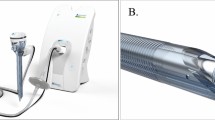Abstract
Background
In central sterile services departments (CSSD), the functionality of rigid endoscopes, which are complex and fragile reusable devices, is usually controlled visually and is considered a complex and subjective task. ScopeControl® was developed to provide an automated quality control of rigid endoscopes by measuring the value of six parameters: viewing angle (VA), field of view (FV), color correctness (CC), light transmission (LT), fibers transmission (FT), and focus (FC). The aim of the present study was to assess the ability of ScopeControl® to pre-emptively identify endoscope defects before the surgeon considers them as defective.
Methods
The same endoscope was evaluated by surgeons during surgery using a scoring scale as well as the CSSD staff using the ScopeControl® during reprocessing. The ScopeControl® categorized the endoscope into 3 groups: “passed,” “in danger,” and “failed.” Correlations between the surgeon’s evaluation and results of the ScopeControl® were calculated.
Results
One hundred sixty-six controls were carried out concerning 51 different endoscopes. According to the surgeon’s evaluation, 78.9% and 80.7% of controls were considered as satisfactory for image and brightness quality, respectively. Results obtained using ScopeControl® found that 13.3% of controls were considered as “passed,” 31.3% “in danger,” and 55.4% “failed,” with poor correlation with the surgeons’ evaluation. LT and FT parameters represented 95.2% of the reasons for failures. The ability of the ScopeControl® to detect endoscope defects earlier than surgeons was validated by tracking the results of endoscopes used and controlled several times.
Conclusion
The ScopeControl® achieved an objective and consistent quality control of endoscopes and showed poor correlation with the surgeon’s opinion. In practice, the ScopeControl® could avoid the use of defective endoscopes in the surgery unit and thus improve the quality of the surgical procedure.


Similar content being viewed by others
References
Ben-Menachem T, Decker GA, Early DS, Evans J, Fanelli RD, Fisher DA, Fisher L, Fukami N, Hwang JH, Ikenberry SO, Jain R, Jue TL, Khan KM, Krinsky ML, Malpas PM, Maple JT, Sharaf RN, Dominitz JA, Cash BD (2012) Adverse events of upper GI endoscopy. Gastrointest Endosc 76:707–718
Amalberti R, Michel P, Quenon J-L, Baudoin D (2008) Leçons pour la sécurité des soins—Flou et flop en endoscopie. Risques Qual 5:42–45
Adler DG (2015) Consent, common adverse events, and post-adverse event actions in endoscopy. Gastrointest Endosc Clin N Am 25:1–8
de Vries EN, Ramrattan MA, Smorenburg SM, Gouma DJ, Boermeester MA (2008) The incidence and nature of in-hospital adverse events: a systematic review. Qual Saf Health Care 17:216–223
Hensman C, Hanna GB, Drew T, Moseley H, Cuschieri A (1998) Total radiated power, infrared output, and heat generation by cold light sources at the distal end of endoscopes and fiber optic bundle of light cables. Surg Endosc 12:335–337
Hindle AK, Brody F, Hopkins V, Rosales G, Gonzalez F, Schwartz A (2009) Thermal injury secondary to laparoscopic fiber-optic cables. Surg Endosc 23:1720–1723
Yavuz Y, Skogås JG, Güllüoğlu MG, Langø T, Mårvik R (2006) Are cold light sources really cold? Surg Laparosc Endosc Percutan Tech 16:370–376
Bombail M, Corvaisier S (2016) Conception des optiques rigides et câbles de lumières utilisés en vidéochirurgie. Stérilisation Centrale. 1:7–14. https://www.mhp-medien.de/fileadmin/MHP/Artikel-FR/Bombail_ZT_F_1_Nov_16.pdf. Accessed 29 June 2020
Noordmans HJ, van Mil I, Daoudi S, Kruit S, van den Brink H, Verdaasdonk R (2006) Optical quality assessment of rigid endoscopes during clinical lifetime. https://ris.utwente.nl/ws/portalfiles/portal/172851412/60820H.pdf. Accessed 29 June 2020
Noordmans HJ, de Braak M, Wientjes R, Martens E, Lindenhovius K, Swart P (2015) Evaluation of the ScopeControl endoscope test system in six hospitals in The Netherlands. Phys Med 31:152–158
Brown J (2017) Case Study for ScopeControl®—automated rigid endoscope testing unit. https://www.dovideqmedical.com/case-study-for-scopecontrol-automated-rigid-endoscope-testing-unit-2. Accessed 29 June 2020
Acknowledgements
This study was made possible thanks to Axone Medical (France, Fabienne Boireau) and Dovideq (Netherlands) who made the ScopeControl® available free of charge for the duration of this study. We thank Véréna Landel (Direction de le Recherche Clinique et de l’Innovation, Hospices Civils de Lyon) for help in manuscript preparation.
Author information
Authors and Affiliations
Corresponding author
Ethics declarations
Disclosure
Pierre Courault, Stéphane Emery, Sofia Boudour, Françoise Rochefort, Alain Ruffion, Claude Dussart, and Stéphane Corvaisier have no conflicts of interest or financial ties to disclose.
Ethical approval
No IRB approval was required for this study.
Additional information
Publisher's Note
Springer Nature remains neutral with regard to jurisdictional claims in published maps and institutional affiliations.
Rights and permissions
About this article
Cite this article
Courault, P., Emery, S., Boudour, S. et al. Quality control of rigid endoscopes: a comparative study between ScopeControl® and surgeons’ evaluation. Surg Endosc 35, 6770–6776 (2021). https://doi.org/10.1007/s00464-020-08181-4
Received:
Accepted:
Published:
Issue Date:
DOI: https://doi.org/10.1007/s00464-020-08181-4




